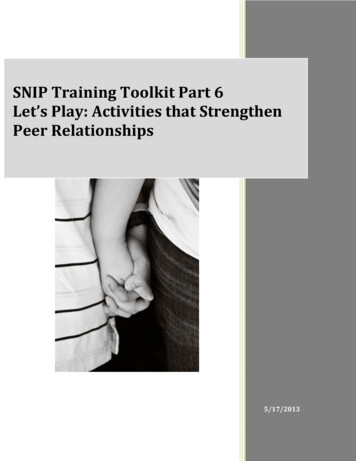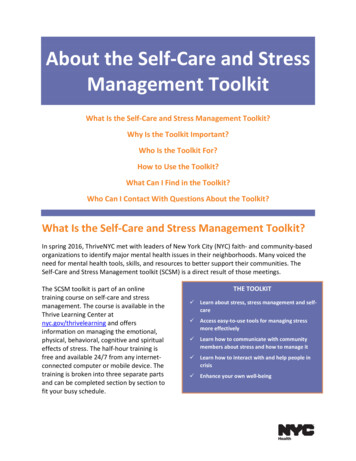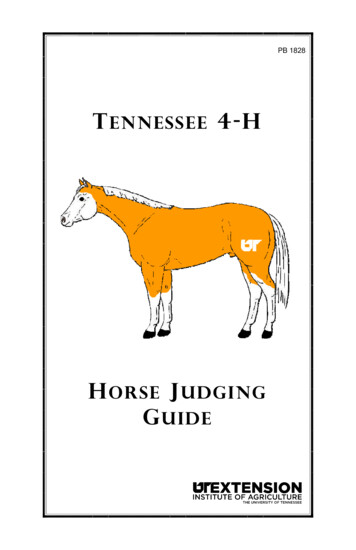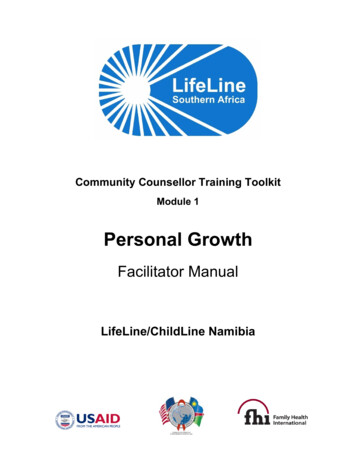
Transcription
SNIP Training Toolkit Part 6Let’s Play: Activities that StrengthenPeer Relationships5/17/2013
Let’s Play! Activities that Strengthen Peer RelationshipsMany children need more than unstructured free time to master social skills. They also need guidance aboutwhich social behaviors to emulate. One way we can help children to learn and develop social skills is by usinginteractive games. Kids learn best when allowed to apply and practice what they're taught in a playful, nonthreatening environment. Incorporating games into lessons is an excellent way to do that.What are important skills for children to master? Research shows us that children with Cooperation,Participation, Validation/Support, Sportsmanship, and Conflict Resolution skills have an easier time making andkeeping friends. Some examples of skills that fall within these categories are:COOPERATION- Turn-taking- Sharing toys/materials- Considering multiple perspectives- Negotiating compromisePARTICIPATION- Staying with the group- Following directions- Joining play- Paying attention to the game or activity- WaitingCOMMUNICATION- Saying what you mean-Understanding what someone has told you- Making appropriate observations and comments- Asking appropriate questions- Active listening- Noticing and interpreting facial expressions andbody language- Sharing humor- Making and responding to requestsVALIDATION - SUPPORT (Friendly-Fun-and-Nice)- Giving positive attention to another person- Giving compliments.- Smiling- Having an awareness of other’s feelings- Offering support or suggestions to a friend whohas a problemSPORTSMANSHIP- Congratulating the winner- Shaking hands and saying, “Good game."- Knowing what to do when you make a mistake- Cheering for everyone on your team- Supporting the team with your attention- Maintaining composure when you loseKEEPING YOUR COOL- Grinning- Making a joke- Keeping your voice calm and quiet- Expressing anger and frustration appropriately- Self Regulation- Self-Reflection ProcessesMany children naturally gain these skills as they mature. While children develop at their own pace, which maydiffer slightly from child to child, we know that relationships with consistent, caring adults as well as access toearly experiences and environments that allow children to practice these emerging skills can go a long waytowards encouraging their positive social emotional development. The following are a number of activities thatpromote important social skills: from giving compliments and staying in line to negotiating a compromise withpeers, and helping out a friend in need.1
Friendship PieThis idea is from the book, Including One Including All by Leslie Roffman and Todd Wanerman. They created asystem of including children with special needs into their program that is relationship based. The children and teachers decided on some kind ways they wanted to treat each other. They listed those ways on the outside of the pie:*Say “yes” and welcome friends to play*share*Keep everyone safe, their bodies and their feelings*Help each other-friends & teachers*Give compliments, or put ups vs. put downs, say nice things They put a sticker on the compliment pie every time someone acted in one of the agreed upon ways. When they got to 100 stickers they had a dance party.Materials Needed: Large paper or Poster-board, Markers, StickersTime it Takes: Initial activity 30 minutes, then ongoingSkills This Builds: COOPERATION, PARTICIPATION, COMMUNICATION, VALIDATION - SUPPORT,SPORTSMANSHIP, KEEPING YOUR COOL (It depends on which kind friendship behaviors you decide to focus on.)Ages: Pre-K through ElementaryHints for Modifying: Use pictures representing the actions in addition to text. Keep the skills simple/moreconcrete for younger children. For older or more socially advanced children you can use moreadvanced/abstract friendship behaviors and stars or check marks instead of stickers.2
Guess the Feeling Identifying and Responding to EmotionsPeople who are good at interpreting facial expressions can better anticipate what others will do and how tointeract with them. They are also more “pro-social,” or helpful towards others. This game allows children towork on the social skills of empathy, self expression and reading body language. Like classic charades, this gamegives children the opportunity to use social skills such as perspective-taking and reading body language.Part I: Players draw slips of paper with emotions written on them (or pictures of expressions portrayingemotions) from a container, and try conveying—without using any words or sounds--the chosen word to theirclassmates. The rest of the kids must guess the emotion being portrayed. Aside from using non-verbalcommunication skills, kids converge and interact socially as they try guessing the word correctly.Part II: Once someone has guessed the correct emotion, choose a student to approach the charades actor and“react” appropriately to the emotion being portrayed.As the actor and “reactor” leave the “stage, encourage the other students to compliment and high-five them.Walk students through the steps of the game first and model the first round.Materials Needed: Feelings Flashcards (photographs of people making different facial expressions)Ideally, try to use multiple models for each emotion. Your collection should include expressions of: happy, sad,scared, angry, disgusted, and surprised as well as other emotions you know your students may be dealing with.Alternately, you can use feeling names written out on scraps of paper.Time it Takes: 15-30 minutes or the amount of time you have.Skills This Builds: COOPERATION, PARTICIPATION, COMMUNICATION, VALIDATION - SUPPORT,SPORTSMANSHIP, KEEPING YOUR COOLAges: Pre-K through ElementaryHints for Modifying: As you are teaching Part II of the game, model the appropriate response first or brainstormoptions as a class before the chosen student approaches the charades actor. Use lanyards/name tags that thestudents wear to delineate the roles (actor, reactor)3
Feelings MatchingHere’s a game that can be played individually or as a group. The idea is to match each facial expression card witha situation that might evoke the emotion. For the game to work, you’ll need to create a second set of cards,each depicting an emotion-evoking situation. The images can come from a number of sources. If you're artistic,you can draw your own. Alternatively, stage and photograph "live" scenarios. Using your students as models canbe a very effective way of engaging them in the game, or use free photos or clip art you can find on the web.Whichever approach you take, make sure the action in the picture is easy to interpret. Here are some ideas forscenarios: A person receiving a gift Someone running from a threat A foot being stepped on An ice cream cone that has fallen on the ground (rendering it inedible) A tower created from toy blocks being kicked over A child sharing A person receiving a high-five A person being snubbed or ignored by others Some situation cards may evoke multiple emotions.Students take turns picking a scenario card, and then choosing the feelings card with the “matching” emotion.OR they pick a feelings card and then choose a scenario card that represents the emotion shown. Either way,encourage them to share with the group why they made the match. Walk your students through the steps of thegame first and model the first round.Materials Needed: Feelings Flashcards (photographs of people making different facial expressions)Ideally, try to use multiple models for each emotion. Your collection should include expressions of: happy, sad,scared, angry, disgusted, and surprised, as well as other emotions you know your students may be dealing with.Scenario FlashcardsTime it Takes: 15-30 minutes or the amount of time you have.Skills This Builds: COOPERATION, PARTICIPATION, COMMUNICATION, VALIDATION - SUPPORT,SPORTSMANSHIP, KEEPING YOUR COOLAges: Pre-K throughHints for Modifying: Limit the field of scenario choices depending on the needs of each student.4
Explaining Facial ExpressionsIn this simple game, players take turns picking a card from the deck and inventing a reason for the facialexpression displayed. For example, if the player picks a card with a woman showing disgust, the player might say“She just stepped in dog poop.” This can also be played as a collaborative game where the students worktogether to create a scenario/story to go with the emotion. Walk students through the steps of the game firstand model the first round.Materials Needed: Feelings Flashcards (photographs of people making different facial expressions)Ideally, try to use multiple people/examples for each emotion. Your collection should include expressions of:happy, sad, scared, angry, disgusted, and surprised, as well as other emotions you know your students may bedealing with.Time it Takes: 15-30 minutes, or the amount of time you have.Skills This Builds: COOPERATION, PARTICIPATION, COMMUNICATION, VALIDATION - SUPPORT,SPORTSMANSHIP, KEEPING YOUR COOLAges: Pre-K through High SchoolHints for Modifying: Provide younger students, or students who need additional support with pre-writtenactivities (or picture scenarios) to choose from. Add the element of collaboration for older/more advancedstudents5
Make the Statue LaughStrong social skills involve the ability to practice self control. In this version of a classic game, one kid plays "It" asall other kids freeze like statues. The "It" kid performs actions, without touching the statues, to make the"frozen" kids laugh, making funny faces, doing a wild dance or making funny noises. The first kid to laughbecomes “It” for the next round. If the "It" kid performs genuinely funny actions and "frozen" kids restrain frombursting into laughter, they successfully show self control. Variations: have all the kids lie on the ground andremain quiet and still. When they move, they are out. The last child to move is the winner. Or set it up so thewhole class wins if everyone stays still for a pre-determined period of time. Have the whole class congratulateeach other on whatever their level of success! Walk students through the steps of the game and model the firstround.Materials Needed: NoneTime it Takes: 15-30 minutes, or the amount of time you have.Skills This Builds: COOPERATION, PARTICIPATION, COMMUNICATION, VALIDATION - SUPPORT,SPORTSMANSHIP, KEEPING YOUR COOLAges: Pre-K through ElementaryHints for Modifying: Display visuals remind the “statues” what they are trying to do (ex: keep body still, stayquiet) and the “It” kids what they are trying to do (ex: be silly, make others laugh) Remind students of thesegoals before each round and throughout the game if necessary.6
Play Skills and Problem-Solving Role Play and PracticeChildren can come up with the greatest solutions. When children own the problem solving process they aremore apt to follow through with the solutions later on because they will remember solutions better if they comeup with them themselves. In this activity, we give children the opportunity to come up with the solution to aproblem they face in your program. Imagine some common problem scenarios in your room. Some examplesare: Two children trying to sit in the same chair A child who is upset Two children wanting the same toy/object. A child with too much or too little energy Two children disagreeingPresent a “common problem” scenario to your students and brainstorm potential solutions. Decide as a groupthe best one or two ways to handle this problem. Then choose actors for each of the roles, set the scene, andtake a video of the children role playing the problem and the first solution. Switch actors for the second solution.Remember to applaud your actors and have them take a bow! These solutions end up being representations ofthe social, play, and self regulation skills we are trying to teach. You can use the videos periodically andproactively, to review and practice these skills before problems arise.Materials Needed: iPad or CameraTime it Takes: 45-60 minutes per problemSkills This Builds: COOPERATION, PARTICIPATION, COMMUNICATION, VALIDATION - SUPPORT,SPORTSMANSHIP, KEEPING YOUR COOLAges: Pre-K through High SchoolHints for Modifying: If you do not have access to video, use a camera or have the students draw pictures of theproblems and solutions. Consider providing example images, or drawings of the scenarios you present to yourchildren to support their understanding of the problem they are being asked to solve.7
Problem Solving WheelVisual Supports can be helpful reminders when kids are already escalated. In those moments, verbalcommunication can be overwhelming and difficult to process for some children. This visual support is a usefultool to remind children of their options when they come across a problem. Personalize this tool by starting witha blank wheel and filling in the potential appropriate actions together as a group. Foster accountability andbuild community by encouraging students to compliment and congratulate each other when they see a friendmaking an appropriate choice when faced with a problem.Materials Needed: Paper, Images of potential solutions, and Markers, OR a large copy of this or similar imageTime it Takes: 15-20 minutes initial introduction, then ongoing useSkills This Builds: COOPERATION, PARTICIPATION, COMMUNICATION, VALIDATION - SUPPORT,SPORTSMANSHIP, KEEPING YOUR COOLAges: Pre-K through High SchoolHints for Modifying: Modify images and solutions to be age appropriate. Carry a small version with you and postlarge versions where conflicts are most likely to occur.8
Following Directions/Self- Control GamesGames such as Follow the Leader, Simon Says and Red Light, Green Light teach kids to listen and follow rules. Inorder to allow children the opportunity to also practice giving clear directions, reverse the roles and let them callthe commands. These games were designed to help children practice paying attention, following directions,remembering rules, and demonstrating aspects of self regulation. To teach them, walk students through thesteps of the game and model the first round. Simon Says/Opposites GameYou can play the classic version of Simon Says, or try this alternative: You ask students to: “Listen to mydirections and do what I say, but don’t let me trick you with what I do.” For example, you say: “Touch yournose,” while you touch your ears. Can they fight the urge and focus only on your words? It can be toughinitially, but will get better with practice! These games require kids to focus on what is important and resistwhat is likely their first impulse. Materials Needed: None Follow the LeaderHave kids line up behind a leader and follow her through an obstacle course. Kids must stay in line, and taketurns as they pass through each section of the course. Alternately, the leader can move around a clear spaceand the followers simply can copy her actions. Materials Needed: None Orange Light, Purple LightLike Red Light, Green Light, a teacher acts as a “stop light” by standing at the opposite end ofthe room from the children. The “stop light” holds up different colors to represent stop and go. In this twist, youcan use different colors or shapes, such as purple for “go” and orange for “stop” or a yellow square for “go,” anda yellow triangle for “stop.” Children can also take turns being the stop light!Materials Needed: Construction PaperTime it Takes: The amount of time you haveSkills This Builds: COOPERATION, PARTICIPATION, COMMUNICATION, VALIDATION - SUPPORT,SPORTSMANSHIP, KEEPING YOUR COOLAges: Pre-K through early ElementaryHints for Modifying: Use visuals to reinforce your directions, and the roles of the games (ex: “LEADER” name tagor lanyard for the leader, Simon or the “stop light” to wear.9
Following Directions/Self- Control Games (continued)Here are a few more games designed to help children practice paying attention, following directions,remembering rules, and demonstrating aspects of self regulation: Drum BeatsTry using drum beats to represent different actions that children can do while sitting (e.g., clapping or stomping)or while moving around the room (e.g., walking or dancing). For example, children walk quickly to fastdrumming, slowly to slow drumming, and freeze when the drumming stopped. You can also change it up and askstudents to respond to opposite cues (walk slowly to fast drum beats and quickly to slow drum beats). MaterialsNeeded: Drum Sleeping ChildrenIn this game, the circle leader sings, “Sleeping, sleeping, all the children are sleeping.” Once children arepretending to sleep, the circle leader says, “And when they woke up they were [monkeys]!” Children wake upand pretended to act like monkeys. The circle leader then repeats the song and suggests other animals. Childrenwho are pretending to sleep are called on to give suggestions for other animals. You can make this morecomplicated by showing 3 different colored circles (ex: red, blue, and purple). On the red circle would be apicture of a snake, on the blue circle was a picture of a butterfly and there was no animal on the purple circle.When it was time to wake up, the circle leader points to one of the circles and the children act out the animal onthat circle. Pointing to the purple circle (the circle with no picture) allows the leader to choose any animal. Aftera few rounds, you can remove the pictures and children have to remember what animal was on each circle.Materials Needed: Construction Paper, Markers FreezeIn a normal game of Freeze, music plays and children dance and jiggle until the music abruptly cuts off and thechildren freeze in place. But in this Tools of the Mind version, as the music plays, the teacher holds a picture of astick figure in a certain pose above her head. The children are supposed to observe the position of the figurewithout doing it, and when the music ceases, they assume that position and that position only. The importantpart of playing the Freeze game this way is the practice of controlling impulses by observing the stick figurewithout immediately doing as the stick figure does. This helps then when they're older, she says. Later in life, ifthey get angry, instead of punching or yelling, they're able to stop themselves. Materials Needed: Music, Imagesof stick figures in various posesTime it Takes: The amount of time you haveSkills This Builds: COOPERATION, PARTICIPATION, COMMUNICATION, VALIDATION - SUPPORT,SPORTSMANSHIP, KEEPING YOUR COOLAges: Pre-K through early ElementaryHints for Modifying: Visuals to represent the elements of Freezing (still body, quiet mouth)10
Collaborative, Improvisational StorytellingTo play this cooperative game, put a set of feelings cards face down on the table. Then players decide togetheron some story elements must appear in the story (e.g., an arctic wasteland, a lemur, and a banana). The goal isfor the players to take turns making up the narrative, building on each other’s ideas and (eventually) making useof all the required story elements. To begin, first player picks a card, and starts the narrative. He can take thestory into any direction he likes, but he must incorporate the emotion depicted on the card. After a minute ortwo, the next player picks a card and continues the narrative. Players continue to take turns until they have usedall the required story elements and reached a satisfying conclusion.Materials Needed: Feelings FlashcardsTime it Takes: 15- 30 minutesSkills This Builds: COOPERATION, PARTICIPATION, COMMUNICATION, VALIDATION - SUPPORT,SPORTSMANSHIP, KEEPING YOUR COOLAges: Elementary through High SchoolHints for Modifying: Consider making a story element deck as well, so that children have visual reminders of theelements they are supposed to be including in the story. Modify story elements to be age appropriate.11
Collaborative ConstructionGroup construction projects present kids with opportunities to pay attention to each other’s efforts,communicate, negotiate, and cooperate! Consider discussing and agreeing to roles (ex: truck driver, foreman,architect, taper, etc) to help students plan how to contribute. Before you being this activity, review problemsolving/conflict mediation strategies with your students. Include time at the end for the group to reflect on theexperience of working together.Materials Needed: Building Supplies (Blocks, Legos, Play Doh, Cardboard etc.)Time it Takes: Depends on the scope of the construction projectSkills This Builds: COOPERATION, PARTICIPATION, COMMUNICATION, VALIDATION - SUPPORT,SPORTSMANSHIP, KEEPING YOUR COOLAges: Pre-K through High SchoolHints for Modifying: Keep activities (length, scope and materials) age appropriate12
Cooperative Ball GamesBall passing games help kids successfully interact with each other in the name of a common goal. Withoutinterruption or dropping a ball, kids hit, kick or toss a ball back and forth. To keep the ball moving back andforth, kids anticipate their partner's actions, and make accommodations based on those actions. How long cantwo (or more) kids keep a ball “in play?” There are many variants of this game. You can kick the ball, toss theball, or hit the ball back and forth (as in volleyball). But the basic id ea is the same: Players move the ball backand forth without dropping it or interrupting the rally. Success depends on anticipating and accommodatingeach other’s actions. Encourage team spirit, supporting each other and achieving common goals, by being veryclear about the goal of working together.Materials Needed: Ball(s)Time it Takes: 10-15 minutesSkills This Builds: COOPERATION, PARTICIPATION, COMMUNICATION, VALIDATION - SUPPORT,SPORTSMANSHIP, KEEPING YOUR COOLAges: Pre-K through ElementaryHints for Modifying: Create the extra role of a “cheerleader,” who cheers and supports the other players to dowell. Then, have the players rotate through each role.13
Plan a PartyThrough this activity, children learn the importance of negotiation and compromise by planning a mock birthdayparty, or a real party for your classroom. Individually, kids mull over choices regarding activities, the lunch foodand type of cake. Once kids identify their favorite and least favorite options, they come together and see whatthey agree on. Kids must come to an agreement about what to eat for lunch, what activity to engage in, andwhat sort of cake to have. You can also include elements like music and decoration colors. Before you play,make an identical set of cards for each participant. Each set should include choices for the elements students areplanning: Cards depicting several different choices of lunch food, including some quirky options (e.g., cards for “pizza,”“peanut butter and jelly,” “noodle soup,” “fish pancakes”). Cards depicting several choices of activity (e.g., “roller skating,” “listening to music”, “playing outside,” “goingto the beach,” “mountain climbing”) Cards depicting several different kinds of birthday cake (e.g., “chocolate cake with vanilla frosting,” “yellowcake with chocolate frosting,” “white cake with vanilla frosting,” “carrot cake with cream cheese frosting).To play, each kid looks over the cards and identifies his favorite and least favorite options. Then kids can try tosee what they agree on. Can they negotiate an agreement? Help kids understand the nature of compromise:They might not be able to agree on their favorites. But maybe they can arrive at an acceptable plan byeliminating options that people really dislike.Materials Needed: Activity/Food/Cake Choice Cards (1 set for each student)Time it Takes: 30- 60 minutesSkills This Builds: COOPERATION, PARTICIPATION, COMMUNICATION, VALIDATION - SUPPORT,SPORTSMANSHIP, KEEPING YOUR COOLAges: ElementaryHints for Modifying: Limit the amount of choices for younger children, pair images with text on the choice cards.Practice the steps of compromising before beginning the activity, and post reminders of the steps that studentscan access during the activity.14
Draw Your DayPlanning requires a lot of energy from the prefrontal cortex. In the Vygotskian-based Tools of the Mindapproach, children are encouraged to create a play plan before engaging in the day’s activities. This simpleprocess encourages future-orientation, and requires children to think before doing, a key aspect of impulsecontrol.Encouraging planning can be as simple as asking your student what they want to play next and asking them todescribe what they’ll do. It could mean taking a few minutes to talk about/plan what your students want to dowith their upcoming quiet time, recess, or trip to the library. Turn it into a written plan by discussing the plans,writing your student’s dictations if necessary, and encouraging her to draw a picture to complete the planningprocess.Go a step further and help older children plan their day, creating a picture schedule or written schedule to helpthem see how they can have time to do both what they need to do and want to do by following a plan. Whendistractions arise, simply remind them of what they’re choosing NOT to do and ask if that’s the choice theywant. This simple exercise helps reinforce an internal locus of control and encourages them to focus on whatthey want most over what they want now (the epitome of impulse control!).Materials Needed: Paper, Markers, Crayons, or Colored PencilsTime it Takes: 5-25 minutesSkills This Builds: COOPERATION, PARTICIPATION, COMMUNICATION, VALIDATION - SUPPORT,SPORTSMANSHIP, KEEPING YOUR COOLAges: Pre-K through High SchoolHints for Modifying: Provide a planning template for students to fill in. Provide images of activities for them tochoose between.15
Ice Breakers and Brain BreaksIce Breakers can be used to introduce a group to one another, or to deepen the connections between studentsthat already know each other. They can help students to identify personal characteristics and to recognizecommonalties within the group. Activity BlocksCreate activity blocks for a quick brain break in the classroom. Use these blocks as a movement activity tobreak the ice in a new group or before your students get too wiggly to focus. Choose students to roll the blocksand lead the activity! Materials Needed: Cardboard, paper, tape Name GameIt is helpful for kids to learn the importance of capturing a person's attention before speaking to them. For thisgame, kids sit in a circle, with one child taking a ball. The child with the ball says the name of another child in thecircle and rolls the ball to him. The child receiving the ball in turn says the name of another child in the circle androlls the ball to her. Play continues in this manner, with kids learning to address the person with whom theywish to speak to. Materials Needed: Soft, Foam Ball I Like My Neighbor Who .Arrange students into a circle where one person is in the middle. The person in the center of the circle beginsthe game by saying “I love my neighbor especially my neighbor who ” She completes the sentence with a pieceof information that is true for her. Example: “I love my neighbor, especially my neighbor who was born outsideof state, loves to play basketball, has a pet, is an only child, etc.”). As soon as she is finished with the statement,everyone (including the person in the center) who this applies to moves from their cone to an empty come thatis not right next to them. The person who remains in the middle begins a second round of the game. MaterialsNeeded: NoneTime it Takes: 10-20 minutes, depending on the size of your groupSkills This Builds: COOPERATION, PARTICIPATION, COMMUNICATION, VALIDATION - SUPPORT,SPORTSMANSHIP, KEEPING YOUR COOLAges: Pre-K through ElementaryHints for Modifying: Remember to take student mobility into consideration16
Say Something NiceMany people have trouble gracefully accepting compliments and may not give compliments easily. Learningthese two social skills is important; compliments are a way of initiating and deepening relationships. They aregreat conversation starters and a way to show appreciation for others. For this activity, have the students sit ina circle and give one player a soft foam ball. That player throws the ball to another child, who has to saysomething nice about the person who just threw the ball to her. For instance, the students can say anythingfrom "You have a pretty smile" to "You tell funny jokes." Continue the game until all of the students have had acompliment given to them by their classmates. Before you begin the activity, practice some compliments withthe group.Materials Needed: Soft Foam BallTime it Takes: 10-20 minutes, depending on the size of your group.Skills This Builds: COOPERATION, PARTICIPATION, COMMUNICATION, VALIDATION - SUPPORT,SPORTSMANSHIP, KEEPING YOUR COOLAges: Pre-K- ElementaryHints for Modifying: Provide compliment templates and reminders for children to use as examples to draw fromif they get stuck.17
Giving FlowersBegin the game by dividing the group into two teams. Line up the teams on one side of the classroom a few feetapart from each other. Select one player from each team to sit in a chair on the opposite side of the room. Givethe first players in each team a bouquet of fake flowers. When you say "Go," the first player runs to histeammate sitting down on the opposite side of the room. He hands her the flowers, saying, "These are for you,"and switches places with her, sitting down in the same chair. She races back to the team and hands off theflowers to the next player in line, saying, "These are for you." The player who receives the flowers has to say,"Thank you," while the giver has to respond, "You're welcome." The first team to have had all its teammates sitin the team’s chair wins the game.Materials Needed: bouquet of flowersTime it Takes: 10-20 minutes, depending on the size of your group.Skills This Builds: COOPERATION, PARTICIPATION, COMMUNICATION, VALIDATION - SUPPORT,SPORTSMANSHIP,
the social, play, and self regulation skills we are trying to teach. You can use the videos periodically and proactively, to review and practice these skills before problems arise. Materials Needed: iPad or Camera Time it Takes: 45-60 minutes per problem Skills This Builds: COOPERA










